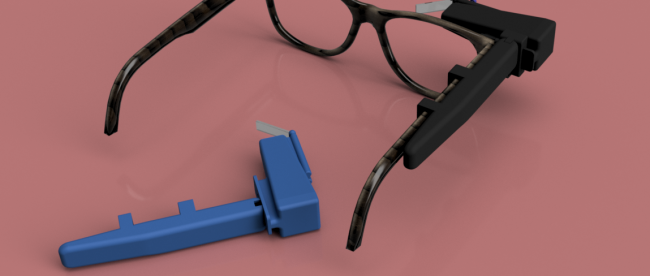TranscribeGlass Adds Distraction Free Closed Captions To Your Glasses
This guest post was written by Madhav Lavakare. Madhav is a young entrepreneur from New Delhi, India. He has had a passion for tinkering, creating, and innovating from a very young age, and has a keen eye for solving problems. With TranscribeGlass, he aims to solve the biggest problem he’s tackled yet: bridging the communication gap between the D/deaf and Hard of Hearing community and mainstream society.
Hi! I’m Madhav Lavakare, a 19-year-old from New Delhi, India. I’m an avid tinkerer and maker and like to think of myself as an Imagineer (noun: imaginative engineer). I’ve been building things ever since I was 6 years old, from solar-powered ovens to bake chocolate chip cookies because my protective parents wouldn’t allow me to use the oven, to a burglar alarm to keep nagging parents out of a messy room, to a home automation system that shuts all the lights and electrical appliances in my room (because my too-sensible parents wouldn’t stop telling me I had to save electricity – sense a pattern here?). The point is, I love solving problems, and building solutions!
Three years ago, when I was in my junior year of high school, one of my friends with hearing loss suddenly dropped out of school. When I asked him why he dropped out, he told me that he had severe hearing loss and couldn’t understand what was being taught, and also couldn’t understand the conversations around him. I asked him about hearing aids or cochlear implants, but he said those were way too expensive, not to mention invasive. I started looking at closed captions and speech-to-text transcription apps. The Live Transcribe app had not yet been created at that time, but other apps like Otter existed. So I asked my friend why he couldn’t use a speech-to-text app. He said that it was virtually impossible for him to understand what was being taught when he had to constantly look down and back up between a phone screen and the speaker.
Through further reading and research, here’s what I came to understand. Hearing aids and cochlear implants are expensive and unaffordable for many deaf/HoH people, especially in developing countries like India. Smart glasses are also expensive, and can be heavy and uncomfortable – they are often designed for different use cases. The reliance on closed captions as a solution via automatic speech recognition (ASR) or human captioning has grown. But they are usually displayed on mobile devices or screens that you have to look down at or away to read the captions, and you miss out on many important aspects of communication. These include – crucial visual cues such as lip-reading, hand gestures, and facial expressions; engagement with the speaker through eye contact; the ability to see any materials they are presenting; and environmental awareness that can help with speaker identification and sound localization. Also, you miss the ability to have your hands free to do other tasks, and you could have a less engaging and meaningful social interaction – constantly having to look at a phone isn’t very conducive to an interactive conversation, is it?
And so, I started thinking about building affordable “real-time smart captioning glasses” for people with hearing loss.
And that’s the origin story of TranscribeGlass. In my next blog post, I will describe TranscribeGlass and talk about the progress we are making towards bringing it to the market!
Check out the gallery below to see people using TranscribeGlass.





Must have a pair !
Where can I get them?
I am totally deaf and if this works as advertised, I really need to have one or two or what ever is required !